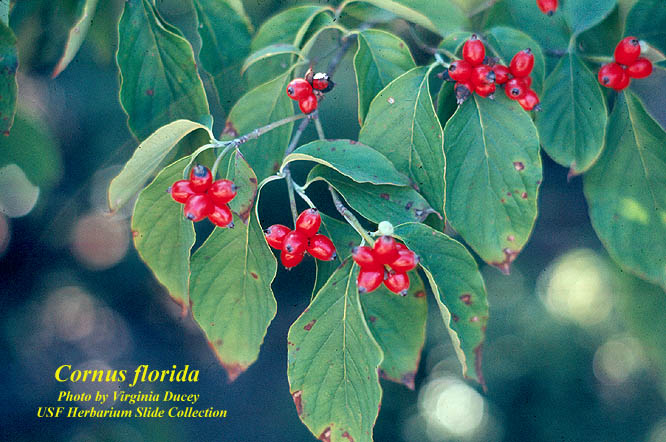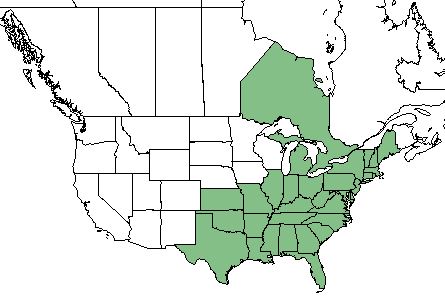Difference between revisions of "Cornus florida"
| Line 35: | Line 35: | ||
===Phenology=== <!--Timing off flowering, fruiting, seed dispersal, and environmental triggers. Cite PanFlora website if appropriate: http://www.gilnelson.com/PanFlora/ --> | ===Phenology=== <!--Timing off flowering, fruiting, seed dispersal, and environmental triggers. Cite PanFlora website if appropriate: http://www.gilnelson.com/PanFlora/ --> | ||
| − | ''C. florida'' flowers February-April, October, and November. <ref name= "PanFlora"> PanFlora Author: Gil Nelson URL: [http://www.gilnelson.com/PanFlora/ http://www.gilnelson.com/PanFlora/] Date Accessed: 5/18/18 </ref> Bark is grayish brown, reddish brown, or black, rough, broken into square blocks; leaves deciduous, opposite, simple, nearly hairless and smooth to touch on upper surface, finely hairy on bottom surface; inflorescence is many flowers crowded into a head, subtended by 4 large and showy white-pink petal-like bracts; fruit is an elliptical drupe, 1-2 seeded, bright red or yellowish at maturity, usually several are crowded together. <ref name= "Gee 1994"> Gee, K. L., et al. (1994). White-tailed deer: their foods and management in the cross timbers. Ardmore, OK, Samuel Roberts Noble Foundation. </ref> | + | ''C. florida'' flowers February-April, October, and November. <ref name= "PanFlora"> PanFlora Author: Gil Nelson URL: [http://www.gilnelson.com/PanFlora/ http://www.gilnelson.com/PanFlora/] Date Accessed: 5/18/18 </ref> Bark is grayish brown, reddish brown, or black, rough, broken into square blocks; leaves deciduous, opposite, simple, nearly hairless and smooth to touch on upper surface, finely hairy on bottom surface; inflorescence is many flowers crowded into a head, subtended by 4 large and showy white-pink petal-like bracts; fruit is an elliptical drupe, 1-2 seeded, bright red or yellowish at maturity, usually several are crowded together. <ref name= "Gee 1994"> Gee, K. L., et al. (1994). White-tailed deer: their foods and management in the cross timbers. Ardmore, OK, Samuel Roberts Noble Foundation. </ref> ''C. florida'' is a bird-dispersed species. <ref name= "Myster and Pickett 1993"> Myster, R. W. and S. T. A. Pickett (1993). "Effects of litter, distance, density and vegetation patch type on post dispersal tree seed predation in old fields." Oikos 66: 381-388. </ref> |
<!--===Seed dispersal===--> | <!--===Seed dispersal===--> | ||
<!--===Seed bank and germination===--> | <!--===Seed bank and germination===--> | ||
Revision as of 14:46, 12 June 2018
Common name: flowering dogwood [1]
| Cornus florida | |
|---|---|

| |
| Photo by the Atlas of Florida Plants Database | |
| Scientific classification | |
| Kingdom: | Plantae |
| Division: | Magnoliophyta - Flowering plants |
| Class: | Magnoliopsida - Dicots |
| Order: | Cornales |
| Family: | Cornaceae |
| Genus: | Cornus |
| Species: | C. florida |
| Binomial name | |
| Cornus florida L. | |

| |
| Natural range of Cornus florida from USDA NRCS Plants Database. | |
Contents
Taxonomic Notes
Synonyms: Cynoxylon floridum (Linnaeus) Rafinesque ex B.D. Jackson; Benthamidia florida (Linnaeus) Spach
Varieties: Cornus kousa House
Description
C. florida is a perennial shrub/tree of the Cornaceae family native to North America and Canada. [1]
Distribution
C. florida can be found in the south- and mid-eastern United States, as well as the Ontario region of Canada. [1]
Ecology
Habitat
C. florida thrives in dry to moist forests and wetlands [2], and does well in understories. [3]
Phenology
C. florida flowers February-April, October, and November. [4] Bark is grayish brown, reddish brown, or black, rough, broken into square blocks; leaves deciduous, opposite, simple, nearly hairless and smooth to touch on upper surface, finely hairy on bottom surface; inflorescence is many flowers crowded into a head, subtended by 4 large and showy white-pink petal-like bracts; fruit is an elliptical drupe, 1-2 seeded, bright red or yellowish at maturity, usually several are crowded together. [5] C. florida is a bird-dispersed species. [6]
Fire ecology
C. florida is not fire resistant, but has a medium fire tolerance. [1]
Use by animals
C. florida is somewhat palatable to browsing animals, not highly palatable to grazing, and inedible for humans. [1]
Diseases and parasites
C. florida has been impacted since the 1980s by widespread infection by the dogwood anthracnose fungus (Discula destructive). [2]
Conservation and Management
C. florida is listed as endangered by the Maine Department of Conservation Natural Areas Program, exploitably vulnerable by the New York Department of Environmental Conservation, Division of Land and Forests, and threatened by the Vermont Department of Fish and Wildlife Nongame and Natural Heritage Program. [1]
Cultivation and restoration
Photo Gallery
References and notes
- ↑ 1.0 1.1 1.2 1.3 1.4 1.5 USDA Plant Database https://plants.usda.gov/core/profile?symbol=COFL2
- ↑ 2.0 2.1 Weakley, A. S. (2015). Flora of the Southern and Mid-Atlantic States. Chapel Hill, NC, University of North Carolina Herbarium.
- ↑ Concilio, A., et al. (2005). "Soil respiration response to prescribed burning and thinning in mixed-conifer and hardwood forests." Canadian Journal of Forest Research 35: 1581-1591.
- ↑ PanFlora Author: Gil Nelson URL: http://www.gilnelson.com/PanFlora/ Date Accessed: 5/18/18
- ↑ Gee, K. L., et al. (1994). White-tailed deer: their foods and management in the cross timbers. Ardmore, OK, Samuel Roberts Noble Foundation.
- ↑ Myster, R. W. and S. T. A. Pickett (1993). "Effects of litter, distance, density and vegetation patch type on post dispersal tree seed predation in old fields." Oikos 66: 381-388.